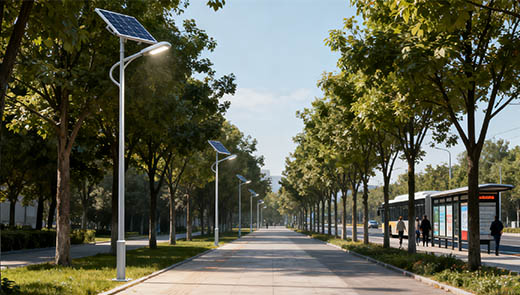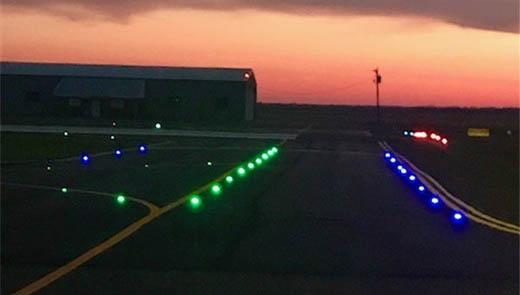Solar Street Lights: Types, Benefits & Applications
In an era where sustainable development and energy efficiency have become global priorities, solar street lights are gradually reshaping the landscape of outdoor lighting through their innovative design and eco-friendly properties. What technological principles underpin these seemingly simple lighting fixtures? And why have they rapidly gained popularity in every corner of cities and rural areas? This article comprehensively analyzes the types, operating mechanisms, core advantages, and practical applications of solar street lights, unveiling the mystery behind this green lighting solution.
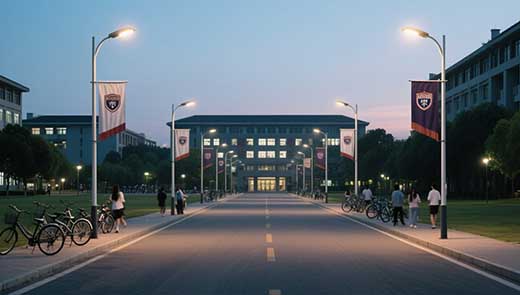
What are Solar Street Lights?
Solar street lights are outdoor fixtures that harness sunlight via solar panels, converting it into electricity for autonomous illumination. Unlike traditional street lights reliant on grid power or fossil fuels, solar street lights operate entirely on renewable solar energy—eliminating complex wiring and ongoing energy consumption costs. Their design seamlessly integrates eco-conscious principles with practical functionality, making them suitable for diverse settings from urban thoroughfares to remote rural paths.
Types of Solar Street Lights
All-in-One Solar Street Light
The integrated solar street light design combines solar panels, batteries, and LED light sources into a single compact unit. Its greatest advantage lies in significantly simplified installation—eliminating the need for separate component placement and substantially reducing installation time and labor costs. Additionally, its small footprint and clean, streamlined appearance preserve the overall aesthetic of the environment. Consequently, it is particularly suitable for areas with limited space, such as narrow sidewalks or small parks, as well as locations prioritizing minimalist design.
All-in-Two Solar Street Light
The two-part solar street light employs a modular design, combining the solar panel and battery into one unit while keeping the LED light source as a separate component. The core advantage of this design is installation flexibility. The solar panel can be angled to maximize sunlight absorption based on lighting conditions without affecting the light source's placement. This configuration excels in areas with uneven illumination—such as locations with obstructions or where separating the light source from the panel is necessary.
Split Solar Street Light
The split solar street light offers the highest flexibility, dividing the solar panel, battery, and LED light source into three independent units that can be installed separately. By strategically positioning each component—such as placing the panel in the sunniest location and the battery in a shaded, protected area—system performance can be optimized. Consequently, they are suitable for large-scale projects like highways and industrial zones, as well as areas requiring separated components for aesthetic or functional reasons.
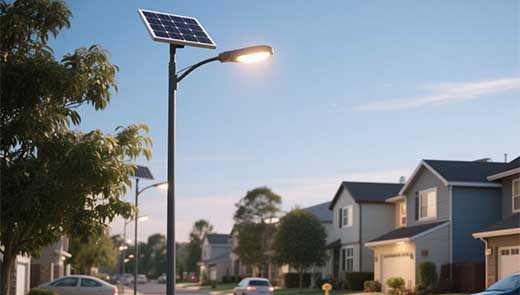
How Do Solar Lights Work?
The core appeal of solar street lights lies in their ability to convert sunlight into electricity and store it for nighttime use, forming an automated cycle.
During daylight hours, solar panels (photovoltaic modules) absorb sunlight and convert it into direct current (DC) electricity via the photovoltaic effect. Subsequently, a charge controller (PWM or MPPT type) regulates energy flow, directing electricity into rechargeable batteries for storage. This controller plays a critical role by preventing overcharging or over-discharging of the batteries, thereby extending their lifespan.
At night, when ambient light diminishes, the light sensor in the luminaire triggers the system to activate. The battery then releases stored energy to power the LED light source, providing nighttime illumination.
At dawn, the controller detects increasing light levels and automatically shuts off the LED light source. The battery re-enters the charging state, repeating this cycle to form a fully automated, self-sustaining system.
Components of Solar Street Lights
Solar Panel
Solar Panel: Equivalent to a “generator,” typically made of monocrystalline or polycrystalline silicon. Its primary function is to capture sunlight and convert it into electrical energy, serving as the core component for solar street lights to obtain power.
Rechargeable Battery
Rechargeable Battery: Used to store energy collected during the day for nighttime use. Currently, lithium-ion or lithium iron phosphate batteries are preferred for their long lifespan, high capacity, and low maintenance requirements, effectively ensuring continuous nighttime illumination.
Controller
Charge/Discharge Controller: The system's “brain,” managing energy flow between the solar panel and battery. It prevents component damage from overcharging or over-discharging while enhancing overall system efficiency. PWM and MPPT are the two most common types.
Light Source
LED Light Source: The “output” of illumination, emitting bright yet energy-efficient light. Equipped with built-in light sensors, LED light sources automatically activate at dusk, ensuring timely illumination.
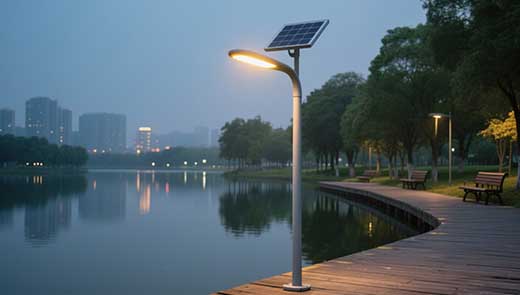
Benefits of Solar Street Lights
Eco-friendly and Energy Saving
Solar street lights operate entirely on solar energy, a renewable resource. This reduces reliance on fossil fuels like coal and oil, cutting greenhouse gas emissions—such as carbon dioxide—from combustion at the source. Amid escalating global warming concerns, this zero-emission characteristic not only aligns with environmental policies but also empowers communities and businesses to embrace green development principles, making tangible contributions to sustainable growth.
Cost-effective
From a cost perspective, solar street lights eliminate monthly electricity bills entirely. For large-scale lighting applications like roads and campuses, they can save tens of thousands of dollars annually in electricity costs. Moreover, they require no complex cable installation to connect to the grid, eliminating expenses for cable procurement, road excavation, and other installation costs. There are also no ongoing maintenance fees for wiring. Although the initial purchase cost is slightly higher, the investment typically pays off within 3-5 years, delivering significant long-term economic benefits.
Modern technology and low maintenance costs
Solar street lights require relatively simple maintenance without frequent inspections by specialized teams. Their batteries last 5-10 years, needing only periodic checks for loose connections. Solar panels boast an even longer lifespan exceeding 25 years, requiring only occasional surface cleaning. Furthermore, the absence of complex wiring eliminates issues like aging cables and short circuits, drastically reducing maintenance frequency and saving substantial labor and costs. This makes them particularly suitable for long-term use in remote areas.
Durable and Safe Option
Solar street lights utilize advanced manufacturing techniques, with housings typically made of corrosion-resistant, impact-resistant aluminum alloy or stainless steel. They withstand severe weather including heavy rain, strong winds, high temperatures, and extreme cold, ensuring stable operation even in coastal humid areas or frigid northern regions. Most products offer a 5-10 year performance warranty. Furthermore, they operate on 12V or 24V low-voltage DC power, completely eliminating high-voltage electrocution risks and preventing fire hazards caused by aging wiring in traditional street lights, ensuring safer and more reliable usage.
Applications of Solar Street Lights
Urban and Suburban Areas
In cities and suburbs, solar street lights illuminate roads, parks, sidewalks, and residential communities. During morning and evening rush hours, consistent lighting enhances traffic safety; park and trail illumination facilitates nighttime recreation for residents. In areas with costly or unstable grid power, they effectively reduce pressure on municipal power systems while providing reliable lighting services.
Rural and Remote Locations
For rural and remote areas, solar street lights serve as a vital lighting solution. They illuminate communities without grid access, remote villages, and country roads, freeing villagers from reliance on flashlights for nighttime travel and ensuring safer journeys home for students after evening study sessions. These lights enhance lighting conditions, safety, and quality of life without requiring massive investments in grid infrastructure.
Parking Lots and Commercial Spaces
Solar street lights are an ideal choice for illuminating parking lots, corporate campuses, and industrial sites. Nighttime lighting in parking lots reduces vehicle scrapes and enhances drivers' sense of security; lighting on corporate campuses improves overall aesthetics and facilitates employee commutes after overtime work. Their autonomous operation and low-maintenance characteristics reduce the workload for property managers while lowering operational costs, making them an economical and practical solution.
Disaster-Prone Regions
In areas vulnerable to storms, earthquakes, or power outages, solar street lights maintain continuous operation. During grid failures caused by earthquakes or typhoons, they guide rescue vehicles and provide essential nighttime illumination for affected communities, reducing panic. Their grid-independent nature ensures critical lighting support even during power collapses, bolstering safety and emergency response capabilities.
Solar street lights are not a passing trend but a sustainable, practical, and economical modern lighting solution. Whether you aim to illuminate rural roads, reduce energy costs for commercial spaces, or enhance lighting reliability in disaster-prone areas, solar street lights meet these needs with proven efficiency and dependability.


